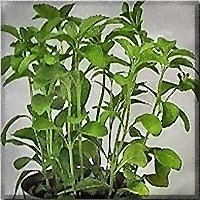

S. rebaudiana
Stevia (also called sweetleaf, sweet leaf or sugarleaf) is a genus of about 150 species of herbs and shrubs belonging to the Asteraceae (sunflower) family, native to subtropical and tropical South America and Central America (north to Mexico). The species are found in the wild in semi-arid habitats ranging from grassland to mountain terrain. Stevia does produce seeds, but only a small percentage of them germinate. Planting cloned stevia is a much more effective method of reproduction.
For centuries, the Guaraní Native Americans of Paraguay and Brazil used Stevia species, primarily S. rebaudiana which they called ka'a he'ê ("sweet herb"), as a sweetener in yerba mate and medicinal teas, for treating heartburn and other ailments. It has recently seen greater attention with the rise in demand for low-carbohydrate, low-sugar food alternatives, and is widely used as a sweetener in Japan, and is available in the US and Canada as a food supplement. Stevia also has shown promise in medical research for treating such conditions as obesity, and high blood pressure.
In 1931, French chemists isolated the >glycosides that give stevia its sweet taste. These extracts were named steviosides and rebaudiosides. These compounds are 250–300 times sweeter than sucrose (ordinary table sugar). Stevia's sweet taste has a slower onset and longer duration than that of sugar. However, it has bitter and liquorice-like after-tastes, especially at high concentration. Stevia does not significantly alter blood glucose, and so is attractive as a sweetener to diabetics and others on carbohydrate controlled diets.
In the early 1970s, the Japanese began cultivating stevia as an alternative to artificial sweeteners such as cyclamate and saccharin, suspected carcinogens. The plant's leaves, the aqueous extract of the leaves and purified steviosides are used as sweeteners. Stevia sweeteners have been produced commercially in Japan since 1977 and are widely used in food products, soft drinks and for table use. Japan currently consumes more stevia than any other country; there, stevia accounts for 40% of the sweetener market.
Today, stevia is cultivated and used in food elsewhere in east Asia, including in China (since 1984), Korea, Taiwan, Thailand and Malaysia; it can also be found in Saint Kitts and Nevis, in part of South America (Brazil, Paraguay, and Uruguay) and in Israel. China is the world's largest exporter of the stevia extract, stevioside.
In 1991, at the request of an anonymous complaint, the United States Food and Drug Administration labeled stevia as an "unsafe food additive" and restricted its import. The FDA's stated reason was "toxicological information on stevia is inadequate to demonstrate its safety." This ruling was controversial, as stevia proponents pointed out that this designation violates the FDA's own guidelines, under which any natural substance used prior to 1958 with no reported adverse effects should be generally recognized as safe (GRAS).
Stevia occurs naturally, requiring no patent to produce it. As a consequence, since the import ban in 1991, marketers and consumers of stevia have shared a belief that the sweetener industry pressured the FDA to keep stevia out of the United States. Arizona congressman Jon Kyl, for example, called the FDA action against stevia "a restraint of trade to benefit the artificial sweetener industry." To date, the FDA has never revealed the source of the original complaint in its responses to requests filed under the Freedom of Information Act.
The FDA requires proof of safety before recognizing a food additive as safe. A similar burden of proof is required for the FDA to ban a substance or label it unsafe. In 1995, recognizing that this burden of proof had not been met, the FDA revised its stance to permit stevia to be used as a dietary supplement, although not as a food additive — a stance that stevia proponents regard as contradictory because it simultaneously labels stevia as safe and unsafe, depending on how it is sold.
Currently, it is legal to import, grow, sell and consume Stevia products in the United States if it is contained within or labeled for use as a dietary supplement. Stevia has also been approved as a dietary supplement in Australia and Canada. It has been grown on an experimental basis in Ontario since 1987 for the purpose of determining the feasibility of growing the crop commercially.
Although unresolved questions remain concerning whether metabolic processes can produce a mutagen from stevia in animals, let alone in humans, the early studies nevertheless prompted the European Commission to ban stevia's use in food in the European Union pending further research. It is also banned in Singapore and Hong Kong.
To date the FDA - has ordered the seizure and destruction of all cookbooks and other literature pertaining to the use of stevia as a food item as being in violation of the Federal Food, Drug, and Cosmetic Act. These products are unapproved food additives in violation of Section 409, and adulterated within the meaning of Section 402(a)(2)(c) of the Act.?
| Aluminum | 0.0072 | Manganese | 0.0147 |
| Ash | 6.3 | Phosphorus | 0.318 |
| Beta-carotene | 0.0075 | Potassium | 1.78 |
| Calcium | 0.544 | Protein | 11.2 |
| Chromium | 0.0039 | Selenium | 0.0025 |
| Cobalt | 0.0025 | Silicon | 0.0132 |
| Fat | 1.9 | Sodium | 0.0892 |
| Fiber | 15.2 | Tin | 0.0015 |
| Iron | 0.0039 | Vitamin C | 0.011 |
| Magnesium | 0.349 | Water | 82.3 |
Stevioside is a white, crystalline powder extracted from the leaves of the Stevia plant. Its chemical identification and quantitative compositions are listed for those with a more scientific interest in the product.